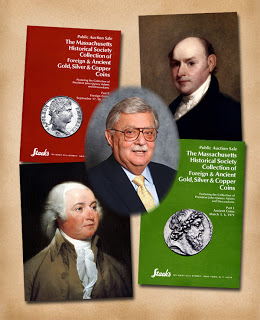
Few know that the Adams family had a coin collection. The Adams family coin collection began with the acquisitions of John Adams. He represented Massachusetts at the Continental Congress, from which came the Declaration of Independence and the forming of the United States. He was later sent to Europe to solicit aid and finances from France to help the new nation establish itself. While in Europe, because of his interest in coins, he and his son John Quincy Adams (who became the sixth president of the U.S.) assembled coins as they related to history, from the time of Greek and Roman civilizations up to the time they lived in.
The entire Adams family was quite literate, each having had a Harvard education. Their letters to each other, diaries, and other documents reflected details of the times they lived in and are cherished as historical treasures today.
In the early 1970s it became obvious to the Massachusetts Historical Society (MHS) that the great historical documents, letters, papers and memorabilia of John Adams and his family, which were stored at the Society, were slowly deteriorating and yet, were not fully available to scholars. Something had to be done to preserve them. However, funds were not available for this mammoth project.
The numismatic items from the Adams family were first stored at the MHS, and were never fully inventoried or studied. In the 1950s the collection was moved to the Museum of Fine Arts in Boston (MFA) to be reviewed and evaluated. Because of its size, this job was worked on slowly. As funds and people were not available to do this, the collection was not fully cataloged or available and selling it was considered as an option. Under the supervision of Cornelius Vermeule, the numismatic curator at MFA and later director of the museum, with the assistance of Mary Comstock of the museum staff, the collection of coins, medals and other numismatic material was cataloged. After the work was done, it was suggested that the collection be sold at public auction in order to provide the funds to properly microfilm and preserve the entire document collection.
Stack’s, with our vast experience in dealing with numismatic treasure held by museums and educational institutions, was selected to sell the coins from the Adams Family collection, and held by the Massachusetts Historical Society.
An interest story is that of when my cousin Norman Stack and I went to Boston to pack up the collection for shipment to New York. The coins and medals were housed in large wooden cabinets, each having some 60 trays to hold the coins. To secure the collection, these cabinets were housed in large storage vaults in the Museum of Fine Arts. The walls of the vault were lined with huge display cabinets, some 12 feet high, each containing a quantity of ancient Greek and Roman heads (from statues). There must have been a thousand or more. All seemed to be looking down at Norman and me. All those “watchful eyes” seemed to provide the security for the collection. As there was no table to use for packing, Dr. Vermeule suggested we use the large wooden case in the center of the floor. We asked what was in the case and he told us it was an Egyptian sarcophagus, intact, which the museum hadn’t had time to unpack! We remarked, “We guess that’s another pair of eyes watching the collection!”
After the collection arrived in New York, Stack’s prepared a series of catalogs in 1971 and 1973 which offered these numismatic treasures for sale at auction. We were fortunate in obtaining a few Photostats of a small inventory of the collection, together with a drawing as how the coins were kept in the trays of the cabinets. All were done originally by the Adams family.
The funds acquired from the sales were used by the Massachusetts Historical Society to photograph and microfilm the Adams papers for the permanent record. It is interesting to learn from the HBO programs, that if one were to take the microfilms of all the papers, the film could stretch for 25 miles. Hence, great history was recorded!
Stack’s sale of the coins from the Adams family holdings served a dual purpose. The proceeds helped retain the documentation of the happenings of the great Adams family. At the same time, numismatists worldwide appreciated the opportunity to compete for and own coins that otherwise would have remained unappreciated in long-term storage.
We at Stack’s are proud to have been selected to perform this work for posterity. For decades Stack’s (and now Stack’s Bowers) has been the auctioneer of choice for museums, universities and other institutions seeking to sell valuable holdings of coins, making funds available for important projects. It is all part of our great heritage.





